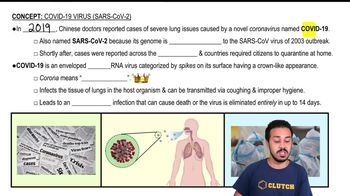Define the following terms, and give an example of how each reaction is used diagnostically:
a. viral hemagglutination
b. hemagglutination inhibition
c. passive agglutination
 Verified step by step guidance
Verified step by step guidance



Define the following terms, and give an example of how each reaction is used diagnostically:
a. viral hemagglutination
b. hemagglutination inhibition
c. passive agglutination
Use the following choices to answer questions 7–9.
a. direct fluorescent antibody
b. indirect fluorescent antibody
c. rabies immune globulin
d. killed rabies virus
e. none of the above
Test used to identify rabies virus in the brain of a dog.
Use the following choices to answer questions 7–9.
a. direct fluorescent antibody
b. indirect fluorescent antibody
c. rabies immune globulin
d. killed rabies virus
e. none of the above
Test used to detect the presence of antibodies in a patient’s serum.
List the causative agent, signs and symptoms, and treatment for four viral diseases of the respiratory system. Separate the diseases according to whether they infect the upper or lower respiratory system.
In San Francisco, ten animal health care technicians developed pneumonia 2 weeks after 130 goats were moved to the animal shelter where they worked. Which of the following is false?
a. Diagnosis is made by a blood agar culture of sputum.
b. The cause is Coxiella burnetii.
c. The bacteria produce endospores.
d. The disease was transmitted by aerosols.
e. Diagnosis is made by complement-fixation tests for antibodies.
Complete the following table:
<IMAGE>